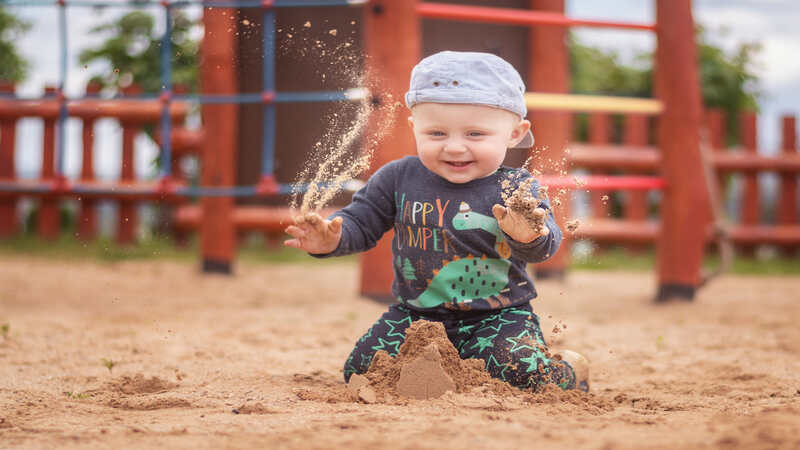 Every parent wants their baby to be active and healthy when they grow up. And the good news is that you can introduce your babies to certain activities which will implant healthy habits in them. One such activity is sand play. There are phenomenal benefits of sand play for babies. It can be played in a sandbox, playground, on a beach, and so on.
Every parent wants their baby to be active and healthy when they grow up. And the good news is that you can introduce your babies to certain activities which will implant healthy habits in them. One such activity is sand play. There are phenomenal benefits of sand play for babies. It can be played in a sandbox, playground, on a beach, and so on.
Sand play not only helps to develop your little one’s fine and gross motor skills but also supports their hand-eye coordination. Moreover, they will become creative which will start to show up in different aspects of their life. Can you tell why some people are active and healthy, and some are lethargic? It’s linked to the activities they got to do when they were little, which formed their good and bad habits. Therefore, you should let your baby play with sand because it’s one of the best habits which will make them nature-loving and active individuals.
In This Article
- What is Sand Play?
- Why is Sand Play Important For Babies?
- Benefits of Sand Play For Babies
- Tips For Sand Play With Your Baby
- Precautions to Take During Sand Play Sessions
- FAQ’s
What is Sand Play?
Sand play is a pastime activity which provides fun and exploration. Babies simply put their hand in the sand and try to feel it. As they continue to play, the may understand that the sand can be moulded. This will lay the foundation for their exploratory play phase. Sand play provides a sensory boost to babies as they play with the sand, feel it and explore it.
Why is Sand Play Important For Babies?
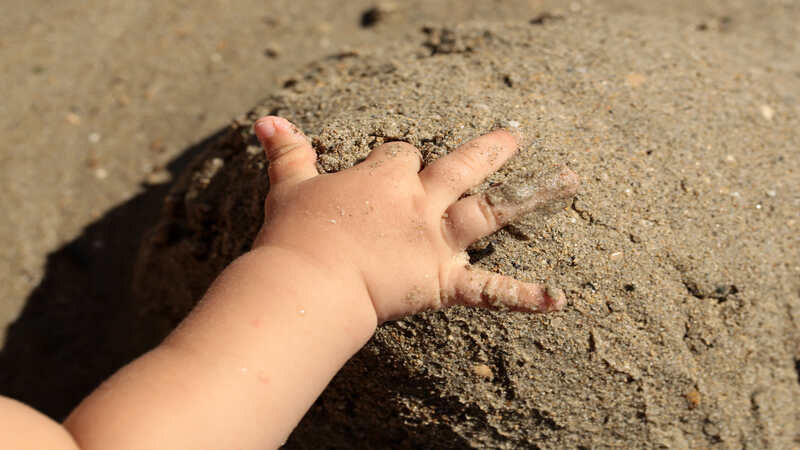
Sand play is an excellent way of babies connecting with the nature apart from experiencing the many developmental benefits that playing with sand offers. Sand play is a cheap way of keeping your baby occupied and also helping them learning new skills. Older babies slowly start understanding the difference between various textures and playing with sand helps them experience and understand a new texture that they might not have encountered before.
Benefits of Sand Play For Babies
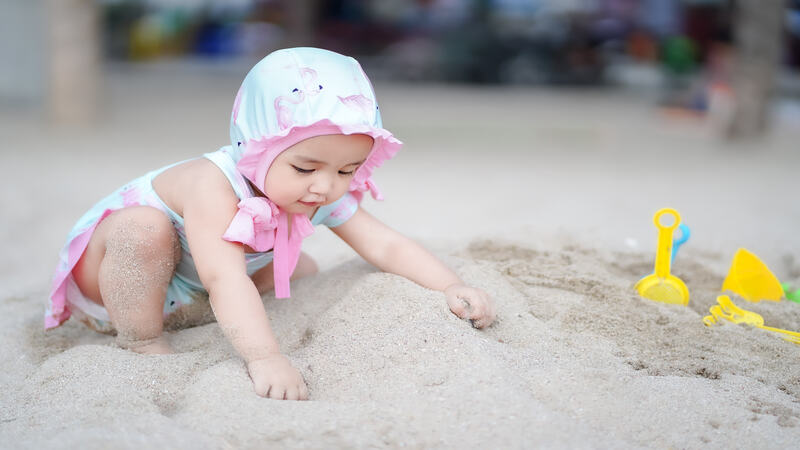
There are both physical as well as mental benefits of sand play. It immensely contributes to the development of their motor skills, senses, and so forth.
1. Fine Motor Development
Sand play is done by hands, and fingers are needed for tasks like lifting the shovel, bucket, etc. Some fine movement of fingers is also required in sand play which further enhances their fine motor skills.
2. Gross Motor Development
You can see sand play as a small workout for your baby. They exercise the muscles of the body while carrying those little buckets, scoops, and so on. Various studies have come out with reliable scientific support that shows that sand play is indeed significant for the motor development of babies.
3. Social Skills
Involve your precious one in social activities in the first year of their life as well as beyond that. When your little one is put in a social situation where there are other babies, their social skills such as coordination, and language abilities skyrocket. Human beings are social creatures. And if you inculcate these healthy habits of making good relationships in their formative years, with others and with you as well, later, they will have good relationships. People with good relationships with their circle enjoy a happier life.
4. Creativity
Creativity is like a muscle. The more we train it, the stronger it becomes. Hand your baby some toys such as cars, animals, a small shovel and so on. You’ll see, your baby will create so many different things out of the sand, they’ll make a world of their own. This skill of thinking out of the box will not just be limited to sand play but will also come out while doing other things like studying, playing with other things, and so on.
5. Hand-Eye Coordination
Hands and eyes work in sync when they see an object and decide to manipulate it and move it finely. Besides, their other senses improve as well. Your baby, for instance, learns to walk over uneven surfaces without falling.
6. Sensory Development
Playing with sand triggers a baby’s interest in textures. Your baby will feel the sand and understand its texture. Older babies may also be able to differentiate between the texture of sand and other items such as their toys and play things. Many babies find the texture of sand comforting and love to spend time feeling it on their hands.
Tips For Sand Play With Your Baby
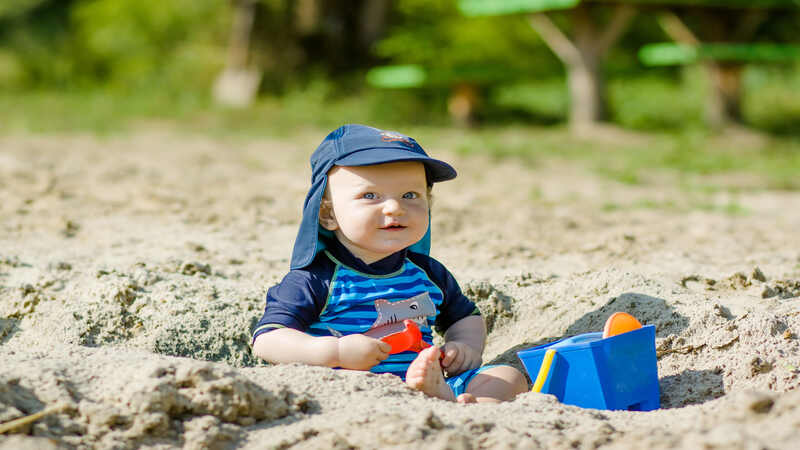
Your baby may be too young for independent sand play. Its always a good idea for you or a caregiver to monitor or even better, play with the baby to make it fun and enjoyable for them.
Here are a few tips for sand play.
1. Create a Sand Box
You may not always be able to allow your baby to go out and play in the sand due to the risk outdoor contaminated sand can pose. You can create a sandbox in your home and get in with your baby. Show them the texture, demonstrate to them how to play; and before you know it, your baby will start really enjoying the activity.
2. Add Toys to The Sandbox
You can make sandbox sand play more interesting by adding your munchkin’s favorite toys. Bury the toys deep in the sand and encourage them to find the toy. Show excitement every time they are able to find the hidden toy. This treasure hunt will keep your munchkin busy and also improve their exploratory and problem solving skills.
3. Introduce Them to Wet And Dry Sand
At the end of their sand play session, wet some sand and show it to them. Repeat words like wet, dry, wet sand and dry sand. This will help them improve their vocabulary skills and also introduce them to a new texture. You can also teach them to make shapes with wet sand.
Precautions to Take During Sand Play Sessions
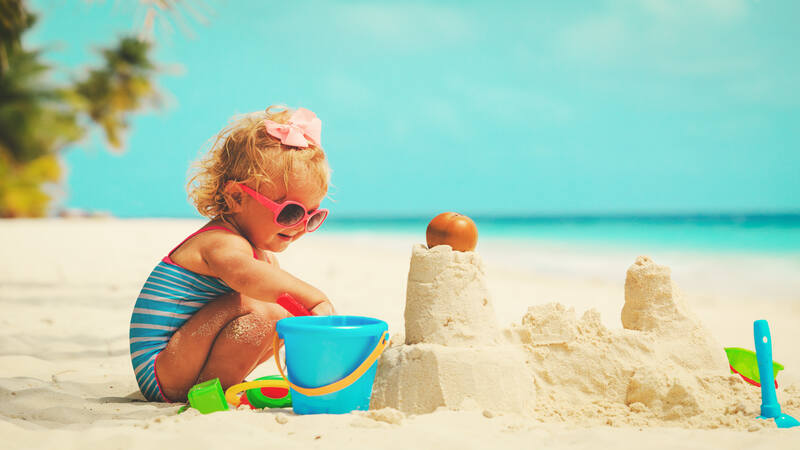
Here are a few precautions you can take to ensure that your baby stays safe during sand play
1. Protect Your Baby’s Eyes
Constantly monitor your baby and ensure that sand doesn’t get into your baby’s eye. Despite your best care if your baby happens to get sand into their eye, look out for signs such as redness or tears from the eyes. Do not allow your baby to touch their eyes. Clean the eye with purified water by tilting their head, Make sure that the affected eye is down. Remember, if your baby rubs their eye, the cornea can get scratched. So it is important to take care that this doesn’t happen.
2. Choose The Right Sand
Choose clean sand picked from river or beach. Commerical colored sand may be unsafe due to chemicals and additives. Avoid sand with materials such as crystalline silica.
3. Choose Your Sand Box Wisely
You can make sand boxes from old delivery cardboard boxes or from plastic boxes. Cover the sand boxes when not in use. Remember insects love sand and we do not want baby’s play sand to be a breeding ground for any insects or infections.
4. Dry Wet Sand Before Covering The Sandbox
If you have wet the sand for your baby to play with, ensure that you dry it out completely before you pack it off. Wet sand can be a breeding ground for bacteria.
Stay close when your little one is playing with sand. Make sure that any harmful and sharp objects like pieces of glass, or animal waste are not around. Surely, there are many benefits of sand play, but you also need to be watchful.
FAQ’s
1. What do Babies Learn When Playing With Sand?
They exercise their muscles when they play with sand. It boosts their creativity and imagination.
2. Is Sand Safe For Babies to Play With?
Yes. But you’ll need to ensure that the sand is changed from time to time and that there are no harmful objects in it.
3. Do You Need to Replace The Play Sand?
Yes, the sand needs to be replaced frequently. Furthermore, if you have pets, don’t let them play with your baby’s sand. It’ll harbor bacteria.

